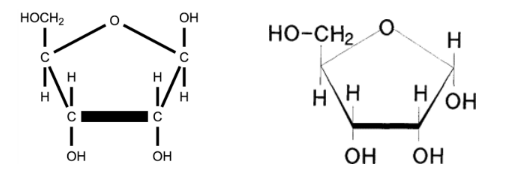Question
(a) Outline energy flow through a food chain. [4]
(b) Draw a fully labelled graph of the action spectrum for photosynthesis. [3]
(c) Explain Calvin’s experiment and what was discovered about photosynthesis through his work. [8]
▶️Answer/Explanation
Ans:
a
a. energy from the sun/light energy is converted to chemical energy by photosynthesis
b. «chemical» energy flows through the food chains by feeding
c. energy is released «from carbon compounds» by respiration OR energy from respiration is used by living organisms and converted to heat
d. heat is not recyclable / heat is lost from food chains OR heat cannot be converted to other forms of energy
e. energy is lost in excretion/uneaten material/egestion/feces
f. energy losses between trophic levels limits the length of food chains OR energy transfer is only 10% between trophic levels
b
a. axes correctly labelled «wavelength and rate of photosynthesis»
b. 400 and 700 nm as limits
c. correct shape of curve involving two peaks at the correct places, broader in the blue-violet range not starting at zero and a narrower peak in the orange-red range with the trough in the green range that does not reach zero
d. peaks of activity at 430 nm AND at 660 nm e. peaks indicated as «violet» blue light AND peak indicated as «orange» red light
c
a. Calvin cycle is light-independent ✔
b. carbon fixation
OR
carboxylation of ribulose bisphosphate/RuBP occurs ✔
c. algae placed in thin glass container/“lollipop” apparatus ✔
d. given plenty of light and bicarbonate/ CO2 ✔
e. at start of experiment algae supplied radioactive carbon/HCO3-/14C ✔
f. samples taken at intervals / heat/alcohol killed samples ✔
g. C-compounds separated by chromatography ✔
h. 14C/radioactive-compounds identified by autoradiography ✔
i. showed that RuBP was phosphorylated ✔
j. after five seconds/immediately more glycerate-3-phosphate/3-PGA labelled than any other compound ✔
k. shows glycerate-3-phosphate/3-PGA first «carboxylated» compound/the first stable product ✔
l. next compound to be detected containing radioactive carbon was triose
phosphate/G3P/glyceraldehyde 3 phosphate ✔
m. showed that a wide range of carbon compounds was quickly made in sequence ✔
n. showed that a cycle of reactions was used to regenerate RuBP ✔
Question
During photosynthesis plants use water in the conversion of light energy to chemical energy
State the name of this process [1]
Explain how water is used in photosynthesis [3]
▶️Answer/Explanation
Ans
a water is split/broken «up»/lysed/undergoes photolysis
b producing/providing electrons
c replaces electrons lost by Photosystem II / PSII / P680 / chlorophyll a
d allows electrons «to continue» to pass along the electron transport chain e provides protons/H+ «inside thylakoid» to help generate a «proton» gradient/maintain high concentration inside thylakoid
For mpa, reject “water is cut in half”. For mpa, accept photolysis only if the context shows that water is being split. For mpc, do not accept just chlorophyll. For mpe, reject pumping of protons into the thylakoid as photolysis produces them inside the thylakoid.
Question
A wide variety of organic compounds are used by living organisms.
(a) Draw a diagram to show the ring structure of D-ribose. [3]
(b) Describe how ATP is produced by Photosystem II in the light-dependent stage of photosynthesis.[5]
(c) Explain how carbohydrates are transported from plant leaves.[7]
▶️Answer/Explanation
a a. ring with four carbons and one oxygen atom;
b. $\mathrm{CH}_2 \mathrm{OH}$ attached to $\mathrm{C} 4$;
c. $\mathrm{OH}$ and $\mathrm{H}$ attached by single bonds to $\mathrm{C} 1, \mathrm{C} 2$ and $\mathrm{C} 3$ with $\mathrm{OH}$ facing downwards on $\mathrm{C} 2$ and $\mathrm{C} 3$;

b a. light (energy) absorbed by pigments/chlorophyll/photosystems;
b. excited electrons passed to electron carriers/electron transport chain;
c. protons/hydrogen ions pumped into thylakoid (space);
d. proton gradient/high proton concentration generated;
e. protons pass via ATP synthase to the stroma;
f. ATP synthase phosphorylates ADP/ATP synthase converts ADP to ATP;
g. photophosphorylation/chemiosmosis;
h. ATP synthase/electron carriers/proton pumps/photosystems/pigment are in the thylakoid membrane;
c a. translocation/movement by mass flow;
b. in phloem sieve tubes;
c. sieve plates/pores in end walls/lack of organelles allows flow (of sap);
d. carbohydrates (principally) transported as sucrose;
e. (sucrose/glucose/sugar/carbohydrate) loaded (into phloem) by active transport;
f. loading/pumping in (of sugars) by companion cells;
g. high solute concentration generated (at the source);
h. water enters by osmosis (due to the high solute concentration);
i. hydrostatic pressure increased/high hydrostatic pressure generated;
j. pressure gradient causes flow (from source to sink);
k. leaves are a source because carbohydrates are made there;
l. transport to the sink where carbohydrates are used/stored;
